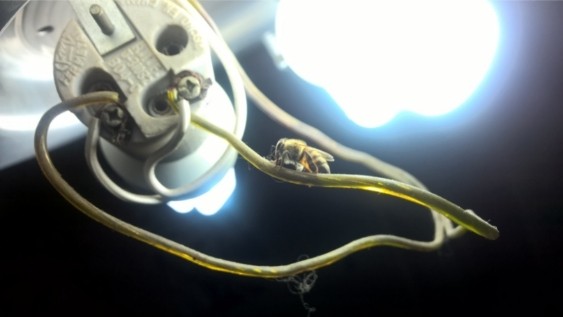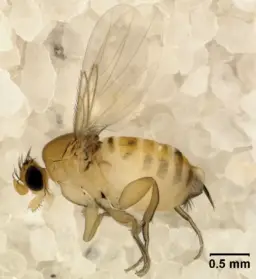Yes, bees are attracted to light. They have an innate positive phototactic response to light, which means they move towards light sources.
This is a common behavior in many animals and insects. Fruit flies and moths are famous examples of insects that react this way when exposed to light.

Why Are Bees Attracted To Light?
The movement of an organism as a response to stimuli from light is called phototaxis. Whenever the organism moves towards it, it’s called positive phototaxis. In contrast, the movement away from light is called negative phototaxis.
Positive phototaxis is natural in honeybees. However, forager bees show a more positive phototactic response to light than young bees. That’s because this attraction to light doesn’t develop until bees are old enough to become foragers and venture outside the hive regularly.
During the first 2 to 3 weeks of age, bees do jobs inside the hive, like taking care of the brood (also known as nursing), where it’s usually dark.
After this stage, they transition to foraging and undergo many changes, including shifts in their endocrine system, brain structure, gene expression, and their response to light.
If you think about it, this makes sense because light becomes more present and essential in their daily activities as they start to go outside the hive.
Are Bees Attracted To Light At Night?
If bees are naturally attracted to light, does this mean they will always fly towards lights in and around your house at night?
It’s unlikely for bees to fly outside the hive at night and become attracted by lights from your house.
Forager bees sleep at night and are significantly less responsive to light during this time. And younger bees, who tend to be more active at night than forager bees, are not as attracted to light. They generally remain in the hive until they are old enough to start foraging.
What Do Bees Do At Night?
The circadian clock of forager bees is like ours. They are active during the day and inactive at night time.
Nursing bees remain active inside the hive at night, but generally don’t venture outside until they are old enough to start foraging.
Studies have confirmed that honeybees sleep. Foragers tend to do this at night
in a position characterized by a relaxed thorax, head, antennae, and minimal movement in the antennae.
There is also evidence of them being less responsive to stimuli during their deep sleep phase. And this includes the stimulus created by light. The intensity has to be 10,000 times higher for a bee in the deep sleep phase to react to light in the way an immobile but awake bee would.
Are Bees Attracted To Bug Zappers?
Bug zappers, or electrocuting insect traps, are designed to kill flying insects by luring them with a UV light bulb. Once they get close enough, the insects are electrocuted by metal grids on either side of the UV light bulb.
UV lights are most effective at night or in dark environments because, during the day, the UV light is not strong enough to overpower the light produced by the sun.
However, because bees tend to remain in their hives at night, it is not common to see them flying toward bug zappers. Theoretically, though, a bug zapper would be effective on a bee flying around at night because bees are attracted to UV light.
Do Bug Zappers Work On Bees?
Because bees don’t fly at night, bug zappers rarely kill them. However, they do kill many other insects that have an essential role in the environment and naturally control pests – including the pests you might be trying to eliminate.
Additionally, a study found the bacteria that accumulate on bugs’ bodies don’t get zapped but instead become tiny particles that fly around the area.
If you are looking for a way to get rid of bees, I’ve written an article about this with tips on how to drive them away without killing them.
Reasons Why Your Bees Could Be Flying Towards Night Lights
Even when it’s unlikely to see bees flying towards the light, it doesn’t mean it never happens! I remember finding one of my bees flying around the light in my laundry room – the closest part of the house to one of my beehives.
Here are two reasons they could be doing this, and what to do about each one:
1. ‘Zombees’ – Phorid Fly, Apocephalus borealis Or Zombie Fly Parasite
In some cases, the reason why bees show a strong attraction to light at night is called Zombie Fly, or by its scientific name, Apocephalus borealis.
This phorid fly generally parasitizes other insects like ants and bumblebees. Recently, it was also confirmed that it parasitized honeybees in North America.
Unsurprisingly, this has raised significant concern as it can become a grave risk to the honeybee population.

Photo Attribution
Core A, Runckel C, Ivers J, Quock C, Siapno T, et al. (2012). “A new threat to honey bees, the parasitic phorid fly Apocephalus borealis.” PLoS ONE 7 (1). DOI:10.1371/journal.pone.0029639. Retrieved on 04 January 2012., CC BY 2.5, via Wikimedia Commons
Parasitized honeybees are called ‘Zombees’ because of their zombie-like behavior characterized by their tendency to leave their hive at night and even during adverse weather conditions. They are also attracted to lights, seem to walk in circles or look disoriented, cannot stand on their legs, and die shortly after.
What To Do If You Suspect Your Bees Have Been Parasitized
First of all, especially if you live in North America, look for other symptoms or behavior like disorientation, loss of balance, hive abandonment, and death.
I highly recommend you check the Zombee Watch website, where you will be able to find reliable information about the Zombie fly parasite, a map of reported cases, and contribute to its research.
Zombee Watch is a citizen science project sponsored by the San Francisco State University Department of Biology, the San Francisco State University Center for Computing for Life Sciences, and the Natural History Museum of LA County.
So far, there are no confirmed cases of Zombees outside North America, so if you live in other countries, it is unlikely your bees are hosting one of these parasites.
However, if you see this zombie-like behavior in your bees and suspect of Zombie Fly parasite, notify your local authorities immediately as it could represent a biosecurity threat.
Australia
Exotic Plant Pest Hotline: 1800 084 881 (plant pests and diseases, weeds and bees).
United Kingdom
Visit: https://www.gov.uk/guidance/bee-health. Government information on other bee-related pests and diseases and contact information to report them.
2. Lights Are Distracting Them Before They Reach Deep Sleep
Bees are less responsive to stimuli during their deep sleep phase – but if you turn on artificial lights at night before bees reach their deep sleep phase, it could cause them to fly towards it.
Your bees could also be bearding outside the hive at night. This would leave them susceptible to being drawn toward nearby lights.
What To Do If Your Bees Are Attracted To Light At Night
To avoid disrupting your bees’ sleep or distracting them at night, ensure your lights, especially those close to your beehives, are turned on a few hours after the sun has set.
This gives them time to reach deep sleep or regulate the temperature inside the hive.
You can also try using red lights as they can’t see this color (as reported by Karl von Frisch in his book Bees: Their Vision, Chemical Senses, and Language).
Summing Up… Are Bees Attracted To Light?
When bees are old enough to forage and leave the hive, they are more positively phototactic, which means they move towards the light. This happens as older bees need to go outside their hive to find food and bring it back to their colony.
However, forager bees are active during the day and sleep at night, reducing the chance of flying at night and therefore getting attracted to lights.
Nevertheless, there a few reasons why this could still happen.
They could be hosting a zombie fly in their bodies – a parasite that alters their behavior and the circadian clock, so they tend to fly towards lights and leave their hive when they usually wouldn’t. Or, they could be distracted by lights if they still haven’t reached the deep sleep phase.
